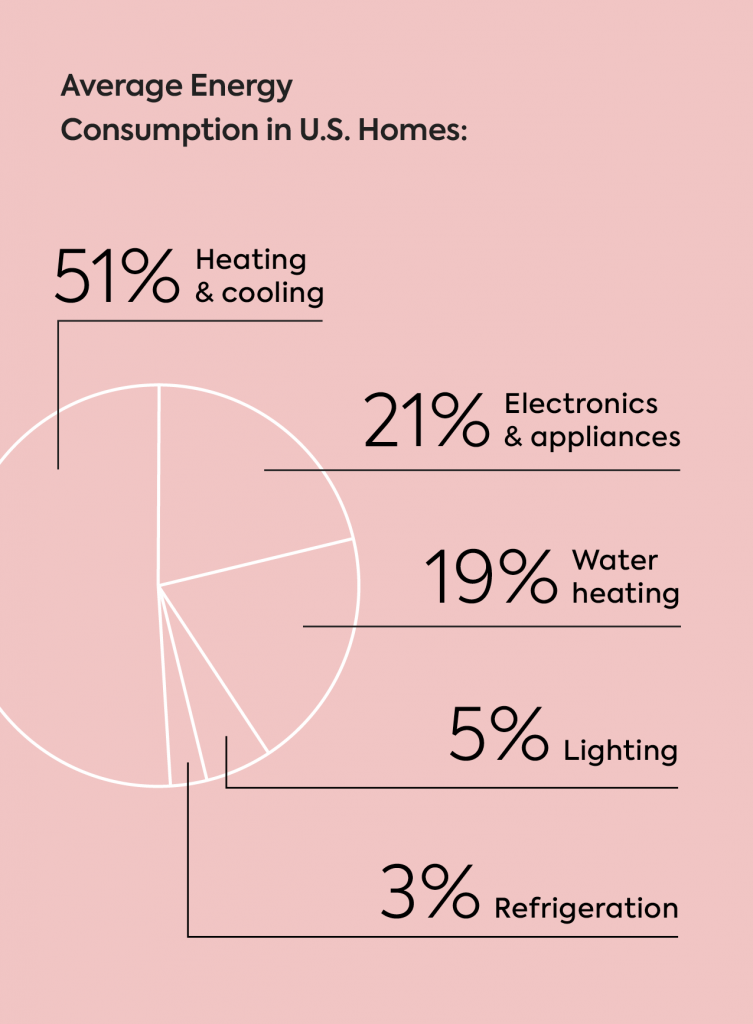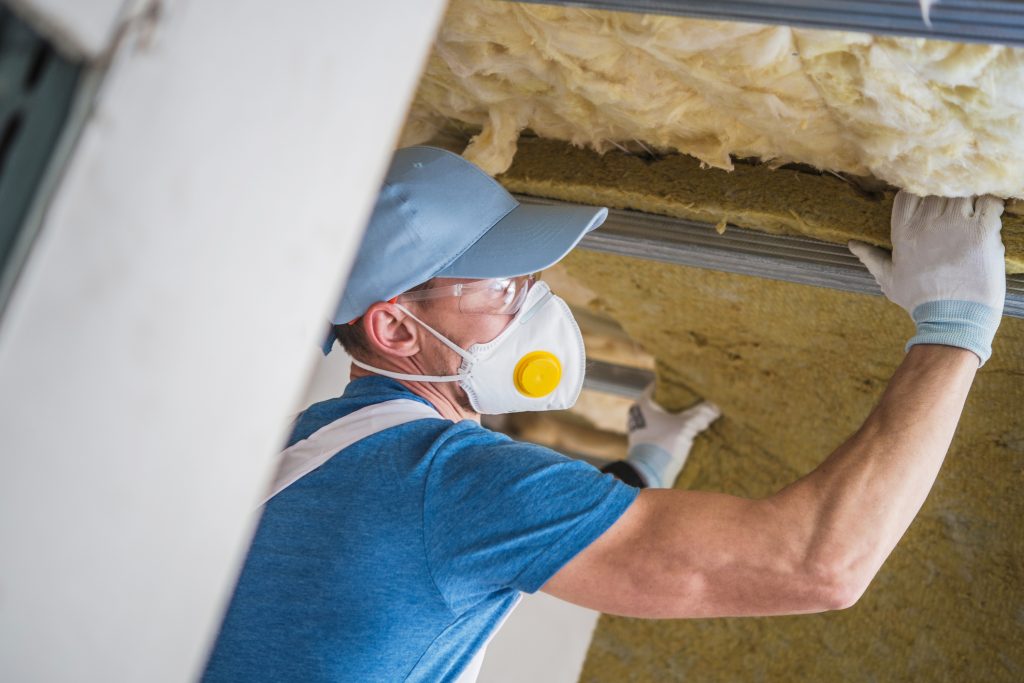Energy costs are rising. Discover tips and tricks to save energy, along with 3 ways to permanently cut energy waste.
We’ve all been there. The latest utility bill arrives and it’s a doozy. You’re left asking yourself: Why is my energy bill so high? How could this be?
When it comes to lowering your energy bills, there are some things you can control—and some you can’t, like the rising cost of natural gas and electricity (or in-laws messing with the thermostat).
In this article, you’ll cover the following:
- Answered: Why is my energy bill so high?
- What costs the most on an energy bill
- How your house racks up high energy bills
- How to stop your house from wasting too much energy
- The best way to get energy upgrades at no upfront cost
- What to do if you’re a renter and have high energy bills
- What to do if you can’t afford your high energy bills
Changing your daily habits can help a bit when your energy bill is high and see things are out of control, but there are better ways to make a bigger impact.
And you’ll learn exactly what they are in this guide.
Spoiler alert: You could get energy-efficient home upgrades at no upfront cost with Sealed. Discover how.
Why is my energy bill so high?
Your energy bill is high because of a few factors, including the increase in:
- Fossil fuel prices, like the rising cost of natural gas
- Electricity costs (which are directly affected by natural gas costs)
- Taxes and fees on your utility bills
- Unseen energy waste in your house
While inflation can easily take the blame, it’s not just that costs and fees, in general, are rising. Your house is also wasting energy in hard-to-see ways.
And if you’re not doing anything about it, it’s likely that it’s getting worse each year, too.
Turning off your lights when you leave the room or switching to LEDs isn’t going to fix it (although those are smart things to do).
But why?
There are three big factors at play when your energy bills are too high, and they work together to get your attention on your monthly statements:
- Taxes, distribution, and fees
- The cost of energy
- Your home’s energy use
First, let’s talk about the factors of a high energy bill that are out of your control as a homeowner: taxes, fees, and the cost of energy.
The costs on your energy bill you can’t control
Factor 1: Taxes, distribution, and fees
These are the charges that help pay for the utility network and its upkeep.
Each year these charges are predetermined by your state’s energy regulators. They account for 30–50% of your bill, and, unfortunately, there’s not a whole lot you can do about them.
Factor 2: The cost of energy
The price of fuel goes up… and it goes down. And lately, the price of energy has been high, especially the cost of natural gas—which also impacts your electricity costs.
When energy costs up, your bills are higher. And when it’s low, well, your bills are lower.
Unless you’re an evil super-genius that can personally impact global energy prices, there’s not much you can do about this one either.
There is one exception, though. If you’re using a third-party gas or electric supplier, they may be charging you prices above market rate.
You can always compare to make sure you’re getting the best price. If you’re not, you should find a new provider.
The costs on your energy bill you CAN control: Your home’s energy use
Your home’s energy use is a biggie, and it’s the one factor you can definitely move the needle on.
In fact, most homes use far more energy than they should.
For example: In our experience from serving thousands of homes, a 1,500 square-foot home could be consuming the energy required for a 2,200 square-foot home.
And all the while, the people who live in it are still experiencing uncomfortable drafts and uneven temperatures, so they crank up the heat even more to stay warm.
Using energy efficient appliances and making energy-saving choices like turning the lights off in empty rooms can help some.
But there’s something that’s causing the most energy waste in your home, and you can’t even see it.

What costs the most on an energy bill?
Heating and cooling your home—by far—uses the most amount of energy.
Over 51% of your home’s energy use is for heating and cooling alone (1).
So if you updated your oven, dishwasher, and refrigerator to energy-efficient appliances, it’s likely you still won’t make a big dent in your energy bills.
(Although you’re sure to save some energy.)
But you know what’s even more difficult to hear?
A significant amount of the air you’re paying to heat and cool your home is lost through air leaks and poor, outdated insulation.
More on that next.
90% of American homes are under-insulated.
NAIMA.org study
Here’s exactly how you rack up high energy bills
It’s not your windows, and it’s not your light bulbs—it’s not even your fridge and freezer running all the time that’s causing high energy bills.
Solving the underlying problem of high energy consumption requires a whole-house solution.
Remember, the majority of energy your home uses (51%) is for heating and cooling.
But a lot of this paid-for air is escaping out of your home through hundreds of open gaps, seams, holes and throughout your house’s structure, called air leaks.
So if your home is suffering from high energy bills, this is likely the big contributor.
Air leaks in your home cause up to 40% of the energy load you use for heating and cooling (2).
Let’s take a pause for a moment: This means if 51% of a home’s energy consumption is used for heating and cooling—and up to 40% of that energy consumption is wasted due to air leaks—there’s a lot of energy waste showing up on your monthly energy bills.
Energy waste that can be stopped.
No one likes to “pay to heat and cool the outdoors,” but that’s exactly what’s happening in the vast majority of American homes.
Learn how to find air leaks in your home.
In the winter, air leaks cause your heating system to be overworked and your energy bills to skyrocket, no matter what type of energy or fuel you use to stay warm in the winter.
In the summer, they cause your AC to work harder, your home to feel uncomfortable, and your energy bills to be—well—high.
This video below gives a good visual of how this happens:
Ultimately, if your home is under-insulated and hasn’t been air sealed, you are literally paying to heat and cool the outdoors and your home is wasting money on energy bills that are higher than they need to be.
That’s pretty bad news.
But here’s the good news: It can be stopped. Your home can feel better and be less wasteful year round.
How to stop your house from wasting money on high energy bills
Making your home more energy efficient is the best way to combat high energy bills—whether it’s the rising cost of natural gas or an electricity price increase.
Check out the High Heating Bill Winter Outlook if you’re curious why heating costs are so high this winter.
Because when it comes to energy costs, there are plenty of factors that are out of your control, including your in-laws messing with your thermostat settings.
We can’t change the cost of energy (sadly)—and neither can you.
But if you’re a homeowner, you can make energy-efficient home improvements that are proven to reduce the waste of the biggest energy-consumer in your house: your HVAC system.
How to make your house more energy-efficient
Heating and cooling systems command a tremendous amount of your home’s energy use.
And old, crumbling insulation, under-insulated areas in your house, and unsealed air leaks cause airflow issues and make the problem of rising energy costs even worse.
These issues are directly responsible for overworking your HVAC system, which leads to bigger energy waste.
Plus, if your house was built before 2000, there’s a good chance that your house wasn’t built with energy-efficiency building codes in mind, so your HVAC equipment is already straining just to keep you and your family comfortable.*
8 out of 10 U.S. single-family homes were built before 2000, when residential energy standards became prevalent.
Statista: Number of homes built in the U.S. between 1900 and 2021

To solve this problem, these are the long-term fixes your home needs:
- Air sealing: Seal up the air leaks that are causing energy waste
- Insulation: Ensure your house has sufficient insulation upgrades
- Efficient HVAC: Maintain your HVAC system for optimum efficiency or switch to a super-efficient heat pump
These energy efficient home upgrades can actually fix the biggest causes of energy waste in your home.
And if you get an energy audit from your local utility or a home performance contracting company, these three issues are likely to pop up as recommended improvements. You can also do a basic form of a home energy audit yourself.
(Are you a renter or need a solution today? Keep scrolling for some short-term efficiency tips below or tap here to jump ahead.)
Air sealing
This is the process of sealing up all the open seams, gaps, and holes that cause your house to take in outside air.
When you professionally air seal your home, a home performance contractor will go from your crawlspace and foundation to your ductwork and attic to expertly resolve air leaks (while fighting off dust bunnies and spiders, too).
Read the Ultimate Guide to Air Sealing to learn more.
High-performance insulation
Most U.S. homes are under-insulated. And even if you’ve upgraded your insulation in the last decade, some types of insulation only last about 10 years before they start to deteriorate.
Plus, your home could have hidden attics and uninsulated spaces, even if it’s a newer build.
Make sure you have the correct amount of insulation for your climate through an energy audit. (Check out What home energy audits are available near me? to see what audits might be available in your neck of the woods.) And if you don’t have enough insulation, plan to make upgrades so you can cut down those high energy bills.
Read The Complete Guide to Attic Insulation to learn more.
Efficient HVAC performance
Your home heating system and air conditioner need annual checkups and maintenance to ensure they’re performing correctly and as efficiently as possible.
And if your HVAC equipment is getting up in age (8+ years), HVAC technology has come a long way in a short time, and there are now more efficient ways to heat and cool your home.
The most efficient HVAC system is the modern heat pump, which can heat and cool your home year round with one appliance. It also works to filter and regulate the humidity in your home, too.
Learn more about how amazing heat pumps are in our Full Guide to Whole-House Heat Pumps.
To sum it up here, at Sealed, we’re Home Energy Experts, and we’ve found with a combo of high-performance insulation, air sealing, and heat pump upgrades, homeowners can reduce their home’s energy use by up to 50%.
Learn how you can get these upgrades at no upfront cost.
Pair these improvements with supplemental changes like LED bulbs, smart home tech, and energy efficient appliances, and you’ll really make an impact on your energy bills.
Short-term quick fixes to lower high energy bills
If you need to lower your energy use pronto, here are a few short-term solutions that you can do in a weekend:
- Install a programmable thermostat. For more information about how a smart thermostat can help, read our Ultimate Guide to Smart Thermostats. Depending on where you live and your income, many utilities provide rebates for these little genius home upgrades.
- Reduce your heating or cooling use. If a smart thermostat is out of your budget right now, try to lower your thermostat by 10 degrees in winter (or increase as much as you can in summer) if you can still stay comfortable and healthy by doing so. Get the best tips for how to stay warm in a cold house or staying cool on a hot day.
- Hang up thermal curtains around your home. Thermal curtains actually work to provide some extra insulation around your windows, although they won’t solve underlying airflow problems. Putting plastic over your windows (like those plastic window insulation kits) doesn’t really work
- Use draft stoppers along your doors. These can help temporarily block drafts, and you can even make one yourself if DIY is your thing.
- Apply solar window film (in the summer to lower extra heat intake). If you have high summer bills, you may be able to pair thermal curtains with solar window film for a slightly higher heat-blocking effect.
- Weatherstrip your doors and windows. Applying fresh weatherstripping to your doors and windows actually works in keeping outside air out, and you can find supplies to do so in most hardware stores.
- Use cold water in your washing machine. It seems like a simple fix, but it can help reduce your home’s hot-water heating energy usage. And it helps your clothes last longer!
- Review ENERGY STAR and Department of Energy recommendations. There are plenty of tools available through these organizations to help you choose appliances that use less energy.
- Conserve, conserve, conserve as much as you can. Unplugging unused electronics and turning off your HVAC system can seem like a hassle (it definitely is). But depending on where you live, there are apps that incentivize these actions by actually paying you to use less energy during peak hours.
These short-term fixes can help a little, but ultimately, they’ll only get you so far.
How to get long-term energy efficiency fixes at no upfront cost
The good news is you don’t need to change your whole life—or drain your savings account—just to make your house more energy efficient.
In fact, you can even set your thermostat to a temperature that YOU like and still cut energy waste. (Yes, you read that right.) All you have to do is give Sealed a call at 917-382-3729.
If your house qualifies, you can even get a free energy assessment.
The bad news? We can’t do anything about your in-laws playing around with your thermostat settings when they visit. Sorry!
Complete our 2-minute questionnaire to see if your house qualifies to work with Sealed and get home-energy upgrades at no upfront cost.
What to do if you’re a renter and have high energy bills
If you’re struggling with the question of Why is my energy bill so high? as a renter, things can get tricky.
The real improvements that most homes require involve permanent fixes (like insulation, air sealing, and HVAC system upgrades), which are in the hands of your landlord or rental company.
If you can’t make big changes to your space, there are a few things you can do to combat energy waste on your own at a rental property. Tap here for the list.
You can also advocate for energy efficient housing with your landlord or rental company.
The same home improvements that help cut energy waste are also excellent for the structure and health of the house (that means they can help protect your landlord’s financial assets!).
Energy-efficient upgrades—including insulation, air sealing, and heat pump HVAC—don’t just influence your energy bills as a renter, but they make houses more comfortable, too, along with helping to:
- Stop ice dams (which homeowners insurance doesn’t often cover)
- Extend the life of the roof and prevent ice dams
- Increase indoor air quality
- Protect against moisture intrusion and humidity problems
- Create a more comfortable house (and more marketable!) rental home
You can also stress to your landlord about the tax incentives under the Inflation Reduction Act for heat pump upgrades and the benefits of the simple switch to a smart thermostat.
What to do if you can’t afford your energy bills
If you can’t afford your high energy bills and you’re experiencing a budgeting emergency, get in touch with your utility company ASAP.
There are federal, state, and local programs that may be able to provide assistance.
You can also:
- Apply for the Low Income Home Energy Assistance Program (LIHEAP)
- Apply for the weatherization assistance program through the Department of Energy
- Check out this list of relief programs available by state
Depending on where you live, you could be eligible for a free energy audit or other helpful energy-saving utility programs in your area.
And make sure to keep an eye out for financial incentives for home upgrades that you may be eligible for under the Inflation Reduction Act of 2022.

Download the FREE guide to making your home more comfortable and efficient
Bonus checklists and case studies included!
*85% of American housing stock was built before 2000, when residential energy-efficiency standards became prevalent in building codes.